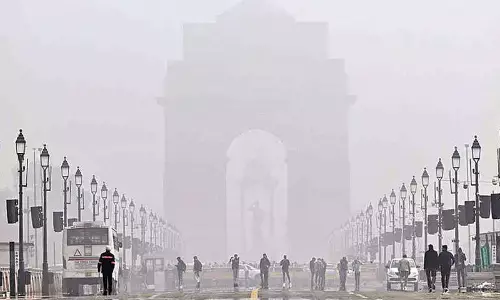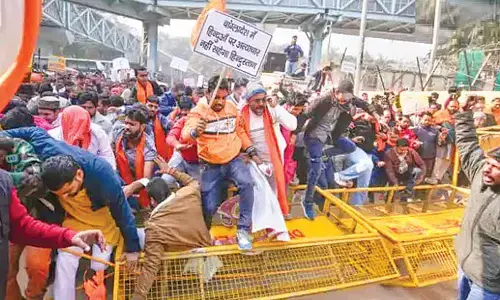RBI policy review, global cues to set the tone

RBI policy review, global cues to set the tone
Tracking weak global cues and uncertainty over economic recovery due to rising Covid-19 infections, equity benchmark indices concluded the September series derivatives expiry week on a negative note.
Tracking weak global cues and uncertainty over economic recovery due to rising Covid-19 infections, equity benchmark indices concluded the September series derivatives expiry week on a negative note. The BSE Sensex crashed by 1,457 points to close at 37,389 and the Nifty ended lower by 445 points at 11,050. From the recent highs, indices have corrected nearly 8.5 percent
till date. Broader markets falling in tandem with benchmarks witnessed 5.2 per cent drop in the S&P BSE Small-cap index, and 4.7 percent fall in the S&P BSE Mid-cap index. Fragile nature of the rally was visible with as many as 103 stocks in the S&P BSE Small-cap index falling 10-20 percent in just five trading sessions. It is pertinent to note that in the last four months, estimated amount raised by primary deals (IPO/Rights/OFS/QIP) is about Rs 1,20,000 crore. Observers say some money is moving out of secondary markets to primary markets resulting in lack of follow up buying in secondary markets.
The 'super quick' recovery of the markets from the March lows was supported by bounce in global markets, domestic and FII inflows, and due to easy money policy.
Near term direction of the markets will be dictated by RBI MPC's monetary policy review meeting scheduled on October 1, geo political issues, macroeconomic data and global cues.
Heard on the Street: The 2020 US presidential election is just five weeks away and observers expect this year's voter turnout will be the highest on record over the past 100 years. Market participants should be prepared for the 2020 presidential election to be a close one and that the results could likely be hotly contested, resulting in unexpected policy uncertainty and corresponding market volatility. It is interesting to recall that the best-performing portfolio over the past 120 years was one that stayed fully invested through both Democratic and Republican administrations.
'Partisan' portfolios – which would invest only when a Democrat or a Republican was in office – underperformed significantly. Surveys show that 1 out of 4 Americans will not accept the result of the election if their candidate doesn't win. These two factors will cause uncertainty to build and global risk assets could experience near-term volatility, with some investors fleeing to safe-haven assets such as gold. Analysts expect Emerging Markets Asia equities to strengthen from current levels into the year-end as the election overhang is removed and investors should refocus on fundamentals, such as an improving economy and likely Covid-19 vaccine in 2021.
Quote of the week: "Life has immense analogy with stock market. It is volatile, but if you stick on long enough, it has the potential to reward you with handsome returns in the long run." - Manoj Arora
F&O/ sector watch
Amidst heightened volatility, settlement week witnessed brisk trading in derivatives segment. With the broader market sentiment turning negative in early September and continuing to be so, the October series is expected to witness sideways movement with a negative bias. Market wide rollover was seen at 93 per cent. However, the Nifty rollover was seen at 71 percent as compared to three-month average of 79 percent. Pharma and metals have witnessed strong rollover along with a negative sectoral momentum, which indicates a further pressure. Realty and IT have seen lower positions being rolled over and suggest reduction in selling pressure in the near term.
Maximum Put Open Interest (OI) was seen at 10,500 followed by 10,000 strike, while maximum Call OI was at 11,500 followed by 12,000 strike.
Marginal Call writing was seen in 11,300 and 11,600 strikes, while Put writing was seen at 10,500 then 10,600 strikes. The Implied Volatility (IV) of Calls closed at 21.92 per cent, while that for Put options closed at 22.41 per cent. The Nifty VIX for the week closed at 23.51 per cent. PCR of OI for the week closed at 1.22 slightly down from the previous week indicating Put unwinding in OTM and Call writing. Techies point that the Nifty bounced back sharply after taking support at its 200-day exponential moving average on daily charts which is placed at 10,845 levels. Expect stock-specific activity to continue amid ongoing consolidation in the range of 11,300-10,800. After month long underperformance, Financials are expected to stage pullback rally. Stock futures looking good are ACC, Berger Paints, Bharti Airtel, Cipla, Infosys, Pidilite Inds, Marico, Ramco Cements, Vedanta and Wipro.
(The author is a stock market
expert. He is former vice
chairman of AP Planning Board)







